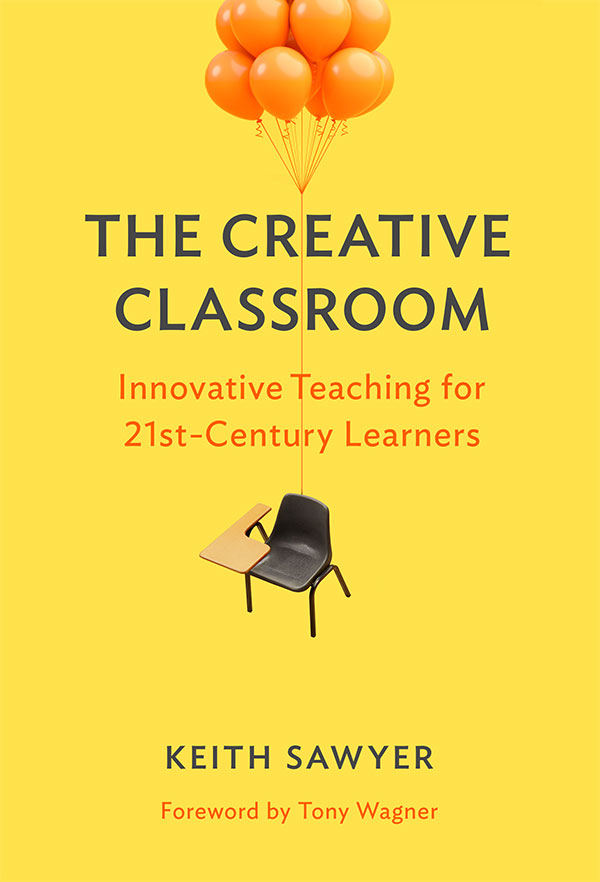Select an item by clicking its checkbox


The Creative Classroom: Innovative Teaching for 21st-Century Learners
Additional Info:
The Creative Classroom presents an original, compelling vision of schools where teaching and learning are centered on creativity. Drawing on the latest research as well as his studies of jazz and improvised theater, Sawyer describes curricula and classroom practices that will help educators get started with a new style of teaching, guided improvisation, where students are given freedom to explore within structures provided by the teacher. Readers will learn how to improve learning outcomes in all subjects—from science and math to history and language arts—by helping students master content-area standards at the same time as they increase their creative potential. This book shows how teachers and school leaders can work together to overcome all-too-common barriers to creative teaching—leadership, structure, and culture—and collaborate to transform schools into creative organizations. (From the Publisher)
Table Of Content:
Foreword (Tony Wagner)
Acknowledgments
Part 1. Introduction
Teaching with Guided Improvisation
Facing the Teaching Paradox
The Creative Teachers of the Future
Part 2. Teaching Creative Knowledge
Creative Knowledge and Shallow Knowledge
Moving Beyond the Coverage Trap
Learning Creativity and State Standards
Creative Habits of Mind
Creative Knowledge in Math, Science, and History
Teaching for Creativity in Every Subject
Part 3. Guided Improvisation
Learning to Improvise
Collaboration and Improvisation
Improv Techniques for Teachers
When Teachers Need to Break the Rules
Lesson Planning for Guided Improvisation
Balancing Structure and Improvisation
Summary
Part 4. Mastering the Teaching Paradox
The Structures of Guided Improvisation
Project-Based Learning and the Teaching Paradox
Managing the Teaching Paradox: Six Case Studies
From Novice Teacher to Expert Improviser
Improvising with Pedagogical Content Knowledge
Summary
Part 5. Schools for Creativity
The Culture of the Creative School
Leadership in the Creative School
The Organizational Structure of the Creative School
Assessment in the Creative School
Summary
Part 6. A Call to Action
References
Index
About the Author
The Creative Classroom presents an original, compelling vision of schools where teaching and learning are centered on creativity. Drawing on the latest research as well as his studies of jazz and improvised theater, Sawyer describes curricula and classroom practices that will help educators get started with a new style of teaching, guided improvisation, where students are given freedom to explore within structures provided by the teacher. Readers will learn how to improve learning outcomes in all subjects—from science and math to history and language arts—by helping students master content-area standards at the same time as they increase their creative potential. This book shows how teachers and school leaders can work together to overcome all-too-common barriers to creative teaching—leadership, structure, and culture—and collaborate to transform schools into creative organizations. (From the Publisher)
Table Of Content:
Foreword (Tony Wagner)
Acknowledgments
Part 1. Introduction
Teaching with Guided Improvisation
Facing the Teaching Paradox
The Creative Teachers of the Future
Part 2. Teaching Creative Knowledge
Creative Knowledge and Shallow Knowledge
Moving Beyond the Coverage Trap
Learning Creativity and State Standards
Creative Habits of Mind
Creative Knowledge in Math, Science, and History
Teaching for Creativity in Every Subject
Part 3. Guided Improvisation
Learning to Improvise
Collaboration and Improvisation
Improv Techniques for Teachers
When Teachers Need to Break the Rules
Lesson Planning for Guided Improvisation
Balancing Structure and Improvisation
Summary
Part 4. Mastering the Teaching Paradox
The Structures of Guided Improvisation
Project-Based Learning and the Teaching Paradox
Managing the Teaching Paradox: Six Case Studies
From Novice Teacher to Expert Improviser
Improvising with Pedagogical Content Knowledge
Summary
Part 5. Schools for Creativity
The Culture of the Creative School
Leadership in the Creative School
The Organizational Structure of the Creative School
Assessment in the Creative School
Summary
Part 6. A Call to Action
References
Index
About the Author